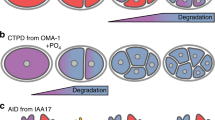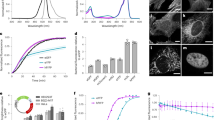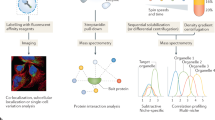Abstract
Understanding the cell biology of many proteins requires knowledge of their in vivo topological distribution. Here we describe a new fluorescence-based technique, fluorescence protease protection (FPP), for investigating the topology of proteins and for localizing protein subpopulations within the complex environment of the living cell. In the FPP assay, adapted from biochemical protease protection assays, GFP fusion proteins are used as noninvasive tools to obtain details of protein topology and localization within living cells in a rapid and straightforward manner. To demonstrate the broad applicability of FPP, we used the technique to define the topology of proteins localized to a wide range of organelles including the endoplasmic reticulum (ER), Golgi apparatus, mitochondria, peroxisomes and autophagosomes. The success of the FPP assay in characterizing the topology of the tested proteins within their appropriate compartments suggests this technique has wide applicability in studying protein topology and localization within the cell.
This is a preview of subscription content, access via your institution
Access options
Subscribe to this journal
Receive 12 print issues and online access
$259.00 per year
only $21.58 per issue
Buy this article
- Purchase on Springer Link
- Instant access to full article PDF
Prices may be subject to local taxes which are calculated during checkout






Similar content being viewed by others
References
Ott, C.M. & Lingappa, V.R. Integral membrane protein biosynthesis: why topology is hard to predict. J. Cell Sci. 115, 2003–2009 (2002).
Wilkinson, B.M., Critchley, A.J. & Stirling, C.J. Determination of the transmembrane topology of yeast Sec61p, an essential component of the endoplasmic reticulum translocation complex. J. Biol. Chem. 271, 25590–25597 (1996).
Chang, X.B., Hou, Y.X., Jensen, T.J. & Riordan, J.R. Mapping of cystic fibrosis transmembrane conductance regulator membrane topology by glycosylation site insertion. J. Biol. Chem. 269, 18572–18575 (1994).
Giraudat, J., Montecucco, C., Bisson, R. & Changeux, J.P. Transmembrane topology of acetylcholine receptor subunits probed with photoreactive phospholipids. Biochemistry 24, 3121–3127 (1985).
Bogdanov, M., Zhang, W., Xie, J. & Dowhan, W. Transmembrane protein topology mapping by the substituted cysteine accessibility method (SCAM(TM)): application to lipid-specific membrane protein topogenesis. Methods 36, 148–171 (2005).
Plutner, H., Davidson, H.W., Saraste, J. & Balch, W.E. Morphological analysis of protein transport from the ER to Golgi membranes in digitonin-permeabilized cells: role of the P58 containing compartment. J. Cell Biol. 119, 1097–1116 (1992).
Wilson, R. et al. The translocation, folding, assembly and redox-dependent degradation of secretory and membrane proteins in semi-permeabilized mammalian cells. Biochem. J. 307, 679–687 (1995).
Lorenz, H., Windl, O. & Kretzschmar, H.A. Cellular phenotyping of secretory and nuclear prion proteins associated with inherited prion diseases. J. Biol. Chem. 277, 8508–8516 (2002).
Liscum, L. & Munn, N.J. Intracellular cholesterol transport. Biochim. Biophys. Acta 1438, 19–37 (1999).
Chen, C., Bonifacino, J.S., Yuan, L.C. & Klausner, R.D. Selective degradation of T cell antigen receptor chains retained in a pre-Golgi compartment. J. Cell Biol. 107, 2149–2161 (1988).
Cole, N.B. et al. Diffusional mobility of Golgi proteins in membranes of living cells. Science 273, 797–801 (1996).
Rizzuto, R., Brini, M., Pizzo, P., Murgia, M. & Pozzan, T. Chimeric green fluorescent protein as a tool for visualizing subcellular organelles in living cells. Curr. Biol. 5, 635–642 (1995).
Soukupova, M., Sprenger, C., Gorgas, K., Kunau, W.H. & Dodt, G. Identification and characterization of the human peroxin PEX3. Eur. J. Cell Biol. 78, 357–374 (1999).
Faber, K.N., Kram, A.M., Ehrmann, M. & Veenhuis, M. A novel method to determine the topology of peroxisomal membrane proteins in vivo using the tobacco etch virus protease. J. Biol. Chem. 276, 36501–36507 (2001).
Klionsky, D.J. Autophagy. Curr. Biol. 15, R282–R283 (2005).
Fengsrud, M. et al. Autophagosome-associated variant isoforms of cytosolic enzymes. Biochem. J. 352, 773–781 (2000).
Cuervo, A.M., Knecht, E., Terlecky, S.R. & Dice, J.F. Activation of a selective pathway of lysosomal proteolysis in rat liver by prolonged starvation. Am. J. Physiol. 269, C1200–C1208 (1995).
Sooparb, S., Price, S.R., Shaoguang, J. & Franch, H.A. Suppression of chaperone-mediated autophagy in the renal cortex during acute diabetes mellitus. Kidney Int. 65, 2135–2144 (2004).
Kabeya, Y. et al. LC3, a mammalian homologue of yeast Apg8p, is localized in autophagosome membranes after processing. EMBO J. 19, 5720–5728 (2000).
Kirisako, T. et al. The reversible modification regulates the membrane-binding state of Apg8/Aut7 essential for autophagy and the cytoplasm to vacuole targeting pathway. J. Cell Biol. 151, 263–276 (2000).
Canfield, V.A. & Levenson, R. Transmembrane organization of the Na,K-ATPase determined by epitope addition. Biochemistry 32, 13782–13786 (1993).
Hegde, R.S. et al. A transmembrane form of the prion protein in neurodegenerative disease. Science 279, 827–834 (1998).
Hegde, R.S. et al. Transmissible and genetic prion diseases share a common pathway of neurodegeneration. Nature 402, 822–826 (1999).
Chalfie, M., Tu, Y., Euskirchen, G., Ward, W.W. & Prasher, D.C. Green fluorescent protein as a marker for gene expression. Science 263, 802–805 (1994).
Gowda, L.R., Joshi, M.S. & Bhat, S.G. In situ assay of intracellular enzymes of yeast (Kluyveromyces fragilis) by digitonin permeabilization of cell membrane. Anal. Biochem. 175, 531–536 (1988).
Cordeiro, C. & Freire, A.P. Digitonin permeabilization of Saccharomyces cerevisiae cells for in situ enzyme assay. Anal. Biochem. 229, 145–148 (1995).
Brown, J.W., Shaw, P.J., Shaw, P. & Marshall, D.F. Arabidopsis nucleolar protein database (AtNoPDB). Nucleic Acids Res. 33, D633–D636 (2005).
Daley, D.O. et al. Global topology analysis of the Escherichia coli inner membrane proteome. Science 308, 1321–1323 (2005).
Ghaemmaghami, S. et al. Global analysis of protein expression in yeast. Nature 425, 737–741 (2003).
Huh, W.K. et al. Global analysis of protein localization in budding yeast. Nature 425, 686–691 (2003).
Liebel, U. et al. A microscope-based screening platform for large-scale functional protein analysis in intact cells. FEBS Lett. 554, 394–398 (2003).
Natter, K. et al. The spatial organization of lipid synthesis in the yeast Saccharomyces cerevisiae derived from large scale green fluorescent protein tagging and high resolution microscopy. Mol. Cell. Proteomics 4, 662–672 (2005).
Acknowledgements
We thank E. Wiertz, A.M. Weissman, Y. Ohsumi, M. Raje and P. Kim for providing DNA constructs used in this study. We also thank E.L. Snapp and R.S. Hegde for valuable discussions on cell permeabilization, and the members of the Lippincott-Schwartz laboratory for their support and critical comments on the manuscript. This work was supported by the Intramural Research Program at the US National Institutes of Health in the National Institute of Child Health and Human Development.
Author information
Authors and Affiliations
Corresponding author
Ethics declarations
Competing interests
The authors declare no competing financial interests.
Supplementary information
Supplementary Fig. 1
Intracellular organelles remain intact upon incubation with digitonin concentrations routinely used for cell permeabilization. (DOC 3658 kb)
Supplementary Fig. 2
Quantitative analysis of fluorescence intensities of the proteins subjected to FPP assays (DOC 2042 kb)
Rights and permissions
About this article
Cite this article
Lorenz, H., Hailey, D. & Lippincott-Schwartz, J. Fluorescence protease protection of GFP chimeras to reveal protein topology and subcellular localization. Nat Methods 3, 205–210 (2006). https://doi.org/10.1038/nmeth857
Received:
Accepted:
Published:
Issue Date:
DOI: https://doi.org/10.1038/nmeth857
This article is cited by
-
Topological and enzymatic analysis of human Alg2 mannosyltransferase reveals its role in lipid-linked oligosaccharide biosynthetic pathway
Communications Biology (2022)
-
FLIP-based autophagy-detecting technique reveals closed autophagic compartments
Scientific Reports (2022)
-
Imaging the electrical activity of organelles in living cells
Communications Biology (2021)
-
Novel ORAI1 Mutation Disrupts Channel Trafficking Resulting in Combined Immunodeficiency
Journal of Clinical Immunology (2021)
-
Degron-tagged reporters probe membrane topology and enable the specific labelling of membrane-wrapped structures
Nature Communications (2019)



